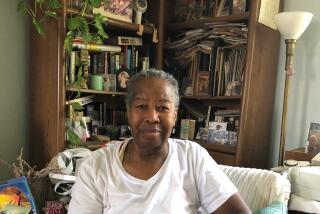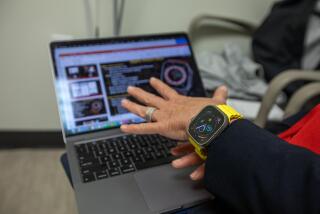Orange Firm Expects Big Market for Wireless Post-Surgical Monitors
- Share via
Buckling up can be a safety measure in the hospital as well as on the freeway.
American Health Products, a tiny, privately held company in Orange, recently obtained approval from the Food and Drug Administration to market a wireless, battery-powered belt worn by patients following surgery. It will sound an alarm if a patient’s breathing falters or stops.
The company believes that the market for respiration monitors will grow with the expanding practice of injecting narcotics around the spine to deaden pain after surgery.
Officials with the American Society of Anesthesiology said using such epidural drugs makes patients comfortable without making them groggy. But in about one in 110 patients, the drugs affect the part of the brain that controls breathing and slows it down.
More rarely--in about 1 in 1,000 patients--the narcotics cause a patient to stop breathing. The injection of an anti-narcotic drug can very quickly stimulate the patient to breathe normally again--if the problem is caught in time.
Rather than have a nurse watch each post-surgical patient around the clock, hospitals have the option of choosing among various hardware monitors that are being sold to do the job automatically.
Some monitor manufacturers who have already entered the market said the reception for their products has been less than overwhelming. Michael Koenig, manager of monitoring products for Air-Shields Vickers, a medical equipment company based in Hatboro, Pa., said his company’s sales of respiratory monitors have been declining. He said some anesthesiologists who have gained familiarity with epidural narcotics believe that the risk of respiratory problems is too small to warrant buying the equipment.
Marketers of similar devices at Hewlett Packard in Andover, Mass., and EdenTec Corp. near Minneapolis, Minn., said they have had to work hard for sales. “If the company (American Health Products) thinks they will hit a home run, they are wrong,” said John Hyle, EdenTec’s vice president of sales and marketing.
But, James M. Kormos, the president and founder of American Health Products, expressed unshaken confidence in his new product, which he contended is much more reliable and convenient than any other that has been available to hospitals.
He said that since the FDA approved the product for sale in June, he has received orders for 360 systems, representing about $1 million in sales.
American Health Products hired MIT Development (no relation to Massachusetts Institute of Technology) in Norwalk, Conn., to design and manufacture the monitor. MIT Development owns a manufacturing plant in Taiwan, where it is turning out the American Health Products monitor at a clip of 200 a month.
Kormos said he and 34 other shareholders in American Health Products have spent $6 million to develop their product in the last six years. He said he has personally invested $500,000. The biggest backers of the technology, he said, are two local real estate investors, who wish to remain anonymous, who together have contributed $3 million.
Kormos said he believes that there is a $200-million potential market in the United States for respiratory and heart monitors for post-surgical patients who have received epidural narcotics and for other patients in pain who receive narcotics intravenously.
He said he plans to exhibit his monitor for post-surgical patients next week in San Francisco at the American Society of Anesthesiology’s annual conference.
American Health Product’s next step, he said, will be to seek FDA approval to sell the monitor for use on infants to prevent crib deaths. He said clinical trials will begin next month.
Unlike competitors’ products, he said, the American Health Products monitor with the Monitron brand name is small and light because all the parts have been painstakingly miniaturized. It is worn as an elastic belt a few inches above the waist. Two-inch squares attached to the belt contain electrodes to monitor heartbeats and other sensors that monitor breathing by measuring the expansion and contraction of a patient’s chest.
A dime-size computer installed in one of the squares can be programmed to detect when a patient’s heart rate goes above or below a specified number of beats per minute or if pauses between breaths become too long.
Patients Freed of Wires
Whereas most other cardiorespiratory monitors tether a patient by wires to a large piece of computerized equipment, Kormos said, patients who wear the Monitron are free of wires.
The belt acts as a radio frequency transmitter that broadcasts to a receiver box kept at a central nursing station. An alarm would also be activated in a pager that can be carried by a nurse.
If something goes wrong with the patient, Kormos said, alarms will ring both on the belt and at the receiver box, and the attending nurse or doctor can obtain a quick numerical readout that shows how the patient’s breathing and heart rates have fluctuated. Pulse and respiratory rates are also continuously shown on a digital display module that can be attached to the patient’s bedclothes.
Sold for $3,500
A Monitron system, which can be used on one patient at a time, is being sold for $3,500, while the programmer that can be used on all the systems sells for $2,000.
In the process of obtaining FDA marketing clearance, Kormos said, the Monitron was tested on 240 patients at seven medical centers, including Stanford University Hospital, the UCLA School of Medicine, Massachusetts General Hospital and the University of Florida College of Medicine.
During the clinical study, he said, the monitor gave off just four false alarms, which were traced to a programming glitch that has since been eliminated.
Dr. Ronald Katz, chairman of the department of anesthesia at the UCLA School of Medicine, said he had tried other makes of respiratory monitors and had been frustrated because they gave too many false alarms.
‘Nothing Wrong With Patient’
“The main reason I was fed up and colleagues were fed up,” he said, “was that the machines would go off when there was nothing wrong with the patient. So you stop believing the machines. They have cried wolf too often, and we have abandoned them.”
But Katz said he is very satisfied with the performance of the Monitron during the tests and he has asked his hospital director to order some of the systems.
Katz said anesthesiologists at each medical center involved in the clinical trials were favorably impressed. “That alone says a lot,” he said, “because we never agree on anything.”
More to Read
Inside the business of entertainment
The Wide Shot brings you news, analysis and insights on everything from streaming wars to production — and what it all means for the future.
You may occasionally receive promotional content from the Los Angeles Times.










